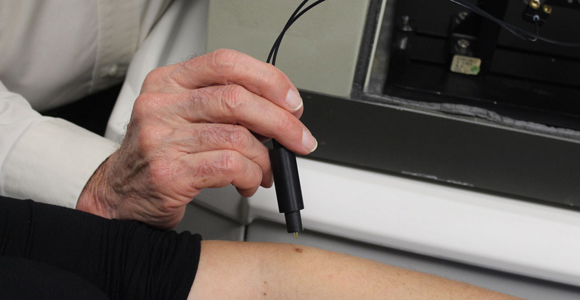
Optical Technology Generates Immediate Melanoma Diagnosis
Written on | Medicine
Expected to revolutionize the field of skin cancer diagnosis.
Melanoma is a life-threatening cancer, but its immediate diagnosis can save lives. An innovative optical technology that can distinguish between different types of cancer has now been developed in the laboratory of Professor Abraham Katzir, from the Raymond and Beverly Sackler Faculty of Exact Sciences at Tel Aviv University, which enables real time diagnosis of melanoma. Based on special optical fibers, the technology will enable every dermatologist to determine the character of a suspicious lesion automatically, and particularly if it is melanoma. Non-invasive, immediate, and automatic, this process may lead to a dramatic change in the field of diagnosing and treating skin cancer, and possibly other types of cancer as well. The technology has been tried successfully on about one hundred patients in a major hospital in Israel. The findings were published in the Journal Medical Physics.Seeing Skin Cancer’s True Colors
When a suspicious lesion is found on the skin, during a routine examination, it is removed in a minor surgical procedure and sent to a laboratory for testing. A pathologist diagnoses the lesion and determines whether it is melanoma. In most cases where melanoma is discovered early, when it is still superficial and less than one-millimeter-thick and it is removed, the patient recovers. Late diagnosis, when the melanoma is more than one-millimeter-thick, significantly reduces the chances of recovery and is life-threatening. “The idea that guided us in developing the technology was that in the visible range, there are various substances, having various colors, which are not characteristic of each substance. On the other hand, in the infrared region, various substances have different ‘colors’ of a sort, depending on the chemical makeup of each substance,” says Professor Katzir. “Therefore, we figured that with the help of devices that can identify these ’colors’, healthy skin and each of the benign and malignant lesions would have different ’colors’, which would enable us to identify melanoma.” Professor Katzir’s research group developed special optical fibers that are transparent in the infrared. The group, in collaboration with physicists Professor Yosef Raichlin of Ariel University, Dr. Max Platkov of the Negev Nuclear Research Center, and Svetlana Bassov of Professor Katzir’s group, developed a system, based on these fibers, in accordance with the requirements of evaluating skin. The researchers connected one end of this type of fiber to a device that measures the ’colors’ in the infrared, and touched the other end lightly, for several seconds, to a lesion on a patient’s skin. The fiber made it possible to check the ’color’ of the lesion right away. Clinical trials were then carried out on suspicious lesions in about one hundred patients. With the help of the new system, physicists performed measurements of the ’color’ of each lesion, before it was removed and sent to a pathology laboratory. The researchers showed that all of the lesions that were determined by pathologists as being of a certain type, such as melanoma, had a characteristic ’color’ in the infrared. Each type of lesion had a different ’color’. “The technology gives us a kind of ‘fingerprint’, which makes it possible to diagnose the various lesions by measuring their characteristic ’colors’”, says Professor Katzir. “In this way, lesions can be diagnosed using a non-invasive optical method, and the physician and the patient receive the results automatically and immediately. This is unlike the test that is routinely used, which involves surgery, and the pathological diagnosis takes a long time.” Following the success of the study, the researchers plan to confirm the evaluation method on hundreds of patients.
Non-invasive, immediate, and automatic
In conclusion, Professor Katzir says: “Melanoma is a life-threatening cancer, so it is very important to diagnose it early on, when it is still superficial. The innovative system will enable every dermatologist to determine the character of a suspicious lesion automatically, and particularly if it is melanoma. This system has the potential to cause a dramatic change in the field of diagnosing and treating skin cancer, and perhaps other types of cancer as well. The challenge will be to make this technology, which is still expensive, something that will be used in every hospital or clinic.”